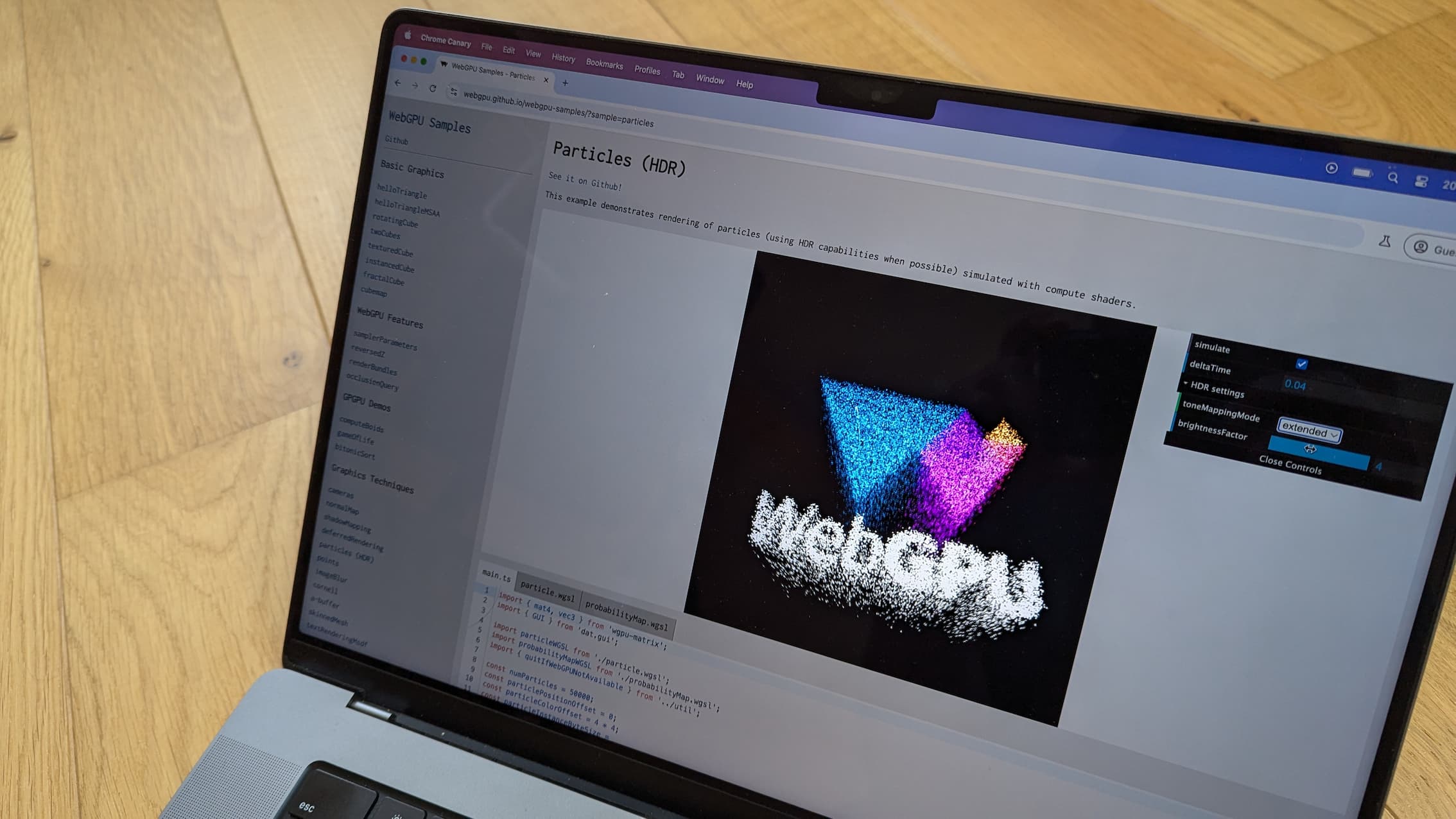HDR support with canvas tone mapping mode
Web developers have limited options for delivering HDR content, relying primarily on <img> and <video> elements. The <canvas> element, however, remains restricted to SDR. Generating dynamic HDR content within a canvas requires encoding its contents as an HDR image before displaying it (for an example see this demo).
The new GPUCanvasToneMappingMode parameter in the WebGPU canvas configuration now allows WebGPU to draw colors brighter than white (#FFFFFF). It does so through the following modes:
"standard": The default behavior restricts content to the SDR range of the screen. This mode is accomplished by clamping all color values in the color space of the screen to the[0, 1]interval."extended": Unlocks the full HDR range of the screen. This mode matches"standard"in the[0, 1]range of the screen. Clamping or projection is done to the extended dynamic range of the screen but not[0, 1].
The following code snippet shows you to configure a canvas for high dynamic range.
const adapter = await navigator.gpu.requestAdapter();
const device = await adapter.requestDevice();
const canvas = document.querySelector("canvas");
const context = canvas.getContext("webgpu");
context.configure({
device,
format: "rgba16float",
toneMapping: { mode: "extended" },
});
Explore HDR with WebGPU by checking out the Particles (HDR) sample and WebGPU HDR example, and see the chromestatus entry.

Expanded subgroups support
Following the announcement of subgroups experimentation, the subgroup built-ins functions are now available for use in both compute shaders and fragment shaders. They are no longer restricted to just compute shaders. See issue 354738715.
Note that the subgroup_size built-in value is currently buggy in fragment shaders. Avoid it for now.
Furthermore, the following subgroup built-ins functions have been added:
subgroupAdd(value): Returns the summation of all active invocationsvalues across the subgroup.subgroupExclusiveAdd(value): Returns the exclusive scan summation of all active invocationsvalues across the subgroup.subgroupMul(value): Returns the multiplication of all active invocationsvalues across the subgroup.subgroupExclusiveMul(value): Returns the exclusive scan multiplication of all active invocationsvalues across the subgroup.subgroupAnd(value): Returns the binary AND of all active invocationsvalues across the subgroup.subgroupOr(value): Returns the binary OR of all active invocationsvalues across the subgroup.subgroupXor(value): Returns the binary XOR of all active invocationsvalues across the subgroup.subgroupMin(value): Returns the minimal value of all active invocationsvalues across the subgroup.subgroupMax(value): Returns the maximal value of all active invocationsvalues across the subgroup.subgroupAll(value): Returns true ifvalueis true for all active invocations in the subgroup.subgroupAny(value): Returns true ifvalueis true for any active invocation in the subgroup.subgroupElect(): Returns true if this invocation has the lowestsubgroup_invocation_idamong active invocations in the subgroup.subgroupBroadcastFirst(value): Broadcastsvaluefrom the active invocation with the lowestsubgroup_invocation_idin the subgroup to all other active invocations.subgroupShuffle(value, id): Returnsvaluefrom the active invocation whosesubgroup_invocation_idmatchesid.subgroupShuffleXor(value, mask): Returnsvaluefrom the active invocation whosesubgroup_invocation_idmatchessubgroup_invocation_id ^ mask.maskmust be dynamically uniform.subgroupShuffleUp(value, delta): Returnsvaluefrom the active invocation whosesubgroup_invocation_idmatchessubgroup_invocation_id - delta.subgroupShuffleDown(value, delta): Returnsvaluefrom the active invocation whosesubgroup_invocation_idmatchessubgroup_invocation_id + delta.quadBroadcast(value, id): Broadcastsvaluefrom the quad invocation with id equal toid.idmust be a constant-expression.quadSwapX(value): Swapsvaluebetween invocations in the quad in the X direction.quadSwapY(value): Swapsvaluebetween invocations in the quad in the Y direction.quadSwapDiagonal(value): Swapsvaluebetween invocations in the quad diagonally.
Dawn updates
The wgpu::PrimitiveState struct now directly includes depth clip control setting, eliminating the need for a separate wgpu::PrimitiveDepthClipControl struct. To learn more, see the following code snippet and the webgpu-headers PR.
// Before
wgpu::PrimitiveState primitive = {};
wgpu::PrimitiveDepthClipControl depthClipControl;
depthClipControl.unclippedDepth = true;
primitive.nextInChain = &depthClipControl;
// Now
wgpu::PrimitiveState primitive = {};
primitive.unclippedDepth = true;
This covers only some of the key highlights. Check out the exhaustive list of commits.
What's New in WebGPU
A list of everything that has been covered in the What's New in WebGPU series.
Chrome 143
Chrome 142
Chrome 141
- Tint IR completed
- Integer range analysis in WGSL compiler
- SPIR-V 1.4 update for Vulkan backend
- Dawn updates
Chrome 140
- Device requests consume adapter
- Shorthand for using texture where texture view is used
- WGSL textureSampleLevel supports 1D textures
- Deprecate bgra8unorm read-only storage texture usage
- Remove GPUAdapter isFallbackAdapter attribute
- Dawn updates
Chrome 139
- 3D texture support for BC and ASTC compressed formats
- New "core-features-and-limits" feature
- Origin trial for WebGPU compatibility mode
- Dawn updates
Chrome 138
- Shorthand for using buffer as a binding resource
- Size requirement changes for buffers mapped at creation
- Architecture report for recent GPUs
- Deprecate GPUAdapter isFallbackAdapter attribute
- Dawn updates
Chrome 137
- Use texture view for externalTexture binding
- Buffers copy without specifying offsets and size
- WGSL workgroupUniformLoad using pointer to atomic
- GPUAdapterInfo powerPreference attribute
- Remove GPURequestAdapterOptions compatibilityMode attribute
- Dawn updates
Chrome 136
- GPUAdapterInfo isFallbackAdapter attribute
- Shader compilation time improvements on D3D12
- Save and copy canvas images
- Lift compatibility mode restrictions
- Dawn updates
Chrome 135
- Allow creating pipeline layout with null bind group layout
- Allow viewports to extend past the render targets bounds
- Easier access to the experimental compatibility mode on Android
- Remove maxInterStageShaderComponents limit
- Dawn updates
Chrome 134
- Improve machine-learning workloads with subgroups
- Remove float filterable texture types support as blendable
- Dawn updates
Chrome 133
- Additional unorm8x4-bgra and 1-component vertex formats
- Allow unknown limits to be requested with undefined value
- WGSL alignment rules changes
- WGSL performance gains with discard
- Use VideoFrame displaySize for external textures
- Handle images with non-default orientations using copyExternalImageToTexture
- Improving developer experience
- Enable compatibility mode with featureLevel
- Experimental subgroup features cleanup
- Deprecate maxInterStageShaderComponents limit
- Dawn updates
Chrome 132
- Texture view usage
- 32-bit float textures blending
- GPUDevice adapterInfo attribute
- Configuring canvas context with invalid format throw JavaScript error
- Filtering sampler restrictions on textures
- Extended subgroups experimentation
- Improving developer experience
- Experimental support for 16-bit normalized texture formats
- Dawn updates
Chrome 131
- Clip distances in WGSL
- GPUCanvasContext getConfiguration()
- Point and line primitives must not have depth bias
- Inclusive scan built-in functions for subgroups
- Experimental support for multi-draw indirect
- Shader module compilation option strict math
- Remove GPUAdapter requestAdapterInfo()
- Dawn updates
Chrome 130
- Dual source blending
- Shader compilation time improvements on Metal
- Deprecation of GPUAdapter requestAdapterInfo()
- Dawn updates
Chrome 129
Chrome 128
- Experimenting with subgroups
- Deprecate setting depth bias for lines and points
- Hide uncaptured error DevTools warning if preventDefault
- WGSL interpolate sampling first and either
- Dawn updates
Chrome 127
- Experimental support for OpenGL ES on Android
- GPUAdapter info attribute
- WebAssembly interop improvements
- Improved command encoder errors
- Dawn updates
Chrome 126
- Increase maxTextureArrayLayers limit
- Buffer upload optimization for Vulkan backend
- Shader compilation time improvements
- Submitted command buffers must be unique
- Dawn updates
Chrome 125
Chrome 124
- Read-only and read-write storage textures
- Service workers and shared workers support
- New adapter information attributes
- Bug fixes
- Dawn updates
Chrome 123
- DP4a built-in functions support in WGSL
- Unrestricted pointer parameters in WGSL
- Syntax sugar for dereferencing composites in WGSL
- Separate read-only state for stencil and depth aspects
- Dawn updates
Chrome 122
- Expand reach with compatibility mode (feature in development)
- Increase maxVertexAttributes limit
- Dawn updates
Chrome 121
- Support WebGPU on Android
- Use DXC instead of FXC for shader compilation on Windows
- Timestamp queries in compute and render passes
- Default entry points to shader modules
- Support display-p3 as GPUExternalTexture color space
- Memory heaps info
- Dawn updates
Chrome 120
- Support for 16-bit floating-point values in WGSL
- Push the limits
- Changes to depth-stencil state
- Adapter information updates
- Timestamp queries quantization
- Spring-cleaning features
Chrome 119
- Filterable 32-bit float textures
- unorm10-10-10-2 vertex format
- rgb10a2uint texture format
- Dawn updates
Chrome 118
- HTMLImageElement and ImageData support in
copyExternalImageToTexture() - Experimental support for read-write and read-only storage texture
- Dawn updates
Chrome 117
- Unset vertex buffer
- Unset bind group
- Silence errors from async pipeline creation when device is lost
- SPIR-V shader module creation updates
- Improving developer experience
- Caching pipelines with automatically generated layout
- Dawn updates
Chrome 116
- WebCodecs integration
- Lost device returned by GPUAdapter
requestDevice() - Keep video playback smooth if
importExternalTexture()is called - Spec conformance
- Improving developer experience
- Dawn updates
Chrome 115
- Supported WGSL language extensions
- Experimental support for Direct3D 11
- Get discrete GPU by default on AC power
- Improving developer experience
- Dawn updates
Chrome 114
- Optimize JavaScript
- getCurrentTexture() on unconfigured canvas throws InvalidStateError
- WGSL updates
- Dawn updates

